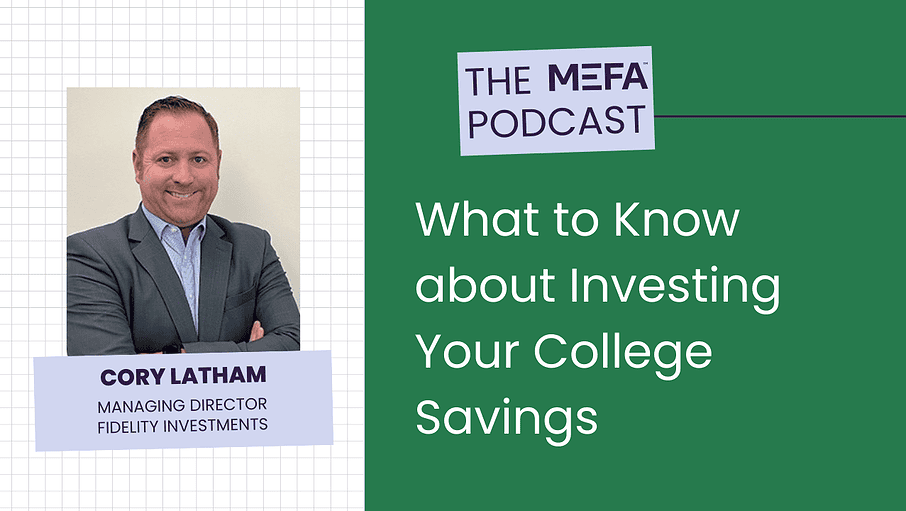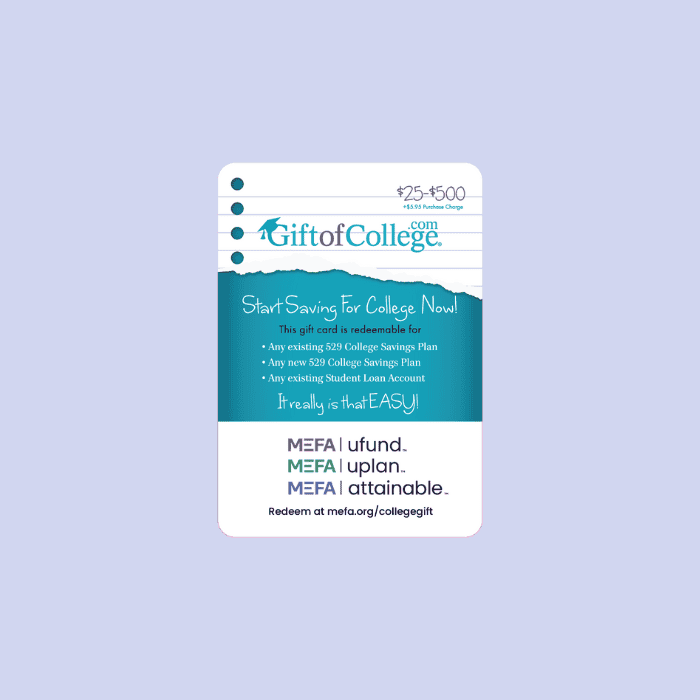Resources Mentioned in this Episode
Jonathan Hughes: [00:00:00] How is investing different than simply saving money?
Cory Latham: Here’s how I describe it. Here’s how I think about it. When you’re saving for something you have a set goal or a set amount of what you’re going to want with it, right? It’s Hey, I need to save for X. So I need to make sure that I have X by this amount.
When I think about investing, what you’re saying is that I am going to put money aside and save for that. Understanding that the funds that I’m doing for will hopefully grow and become more than it is, there’s also always going to be a risk when it comes to investing that those funds don’t grow. But understanding that money you’re putting aside is going to be going to work for you.
Jonathan Hughes: Hey [00:01:00] everyone and welcome to the MEFA Podcast. My name is Jonathan Hughes And you just heard from our guest on the show today Cory Latham from Fidelity Investments And we are going to talk all about college savings today. In fact, we’re going to talk about college investments today see part of opening a 529 plan is you have to pick Your investment strategy and that really confuses a lot of people it confused me when I was opening mine for my son, what we’re going to talk about today is just the basics of investing and why this is an investment vehicle.
What kind of investment questions are you going to have to answer and how you can make sense of this if you are not a seasoned investor, like I am not a seasoned investor. I’ll be back with the wrap up later on, but please enjoy this conversation on college investing. Now let’s hear from our guest.
Cory Latham: I am Cory [00:02:00] Latham. I am a Managing Director at Fidelity Investments and a State Relationship Manager specifically for the U Fund and the Attainable Savings Plan. I have been at Fidelity. This is my 20th year.
Jonathan Hughes: Great. Thank you so much. And as I, I just mentioned we’re so excited to have you on because we are such good partners, MEFA and Fidelity. And so I was wondering if you could explain a little bit about how MEFA and Fidelity work together.
Cory Latham: Yeah, absolutely. So the way that it works with both 529 plans, also with ABLE accounts is that there’s a state sponsor. So in this area, MEFA would be the state sponsor of both of those plans and those programs. So at SAP Fidelity, we work as the program manager. So in our role, Of the program manager. We manage the investments within each of those different plans. It also the operations and the customer service aspects of those plans as well. So that’s the collaboration that we [00:03:00] have between me and fidelity.
Jonathan Hughes: And so can you explain just in case anybody isn’t sure, just a high level explanation of what the 529 plans that you mentioned are.
Cory Latham: It’s a great question. And it’s it comes up often. So it’s a more common question than I think people would assume. So I think at the most basic definition, what a 529 plan is, it’s a tax advantage account that can be utilized to save for qualified education expenses, right? What the biggest benefit is that the tax advantage is that any earnings in the account grow tax deferred and as long as they’re utilized for a qualified education expense, those withdrawals are tax free. And what’s interesting with qualified expenses, I think a lot of people tend to think tuition room board, those do qualify, but there’s also expanded uses of what the 529 can be used for, and we can touch on that but it is a lot broader than just simply those three.
A lot in the last couple of years have gone towards making it more open and what you [00:04:00] can use a 529 plan for. So definitely something that’s exciting for those are the counts.
Jonathan Hughes: We’re talking about investing here today, right? So how is investing different than simply saving money?
Cory Latham: So that’s a great question. And it’s one that I’ve actually spent a lot of time thinking about because in many ways. They’re the same. And I think those words can get used interchangeably saving for college, investing for college. Here’s how I describe it. Here’s how I think about it. When you’re saving for something you have a set goal or a set amount of what you’re going to want with it.
It’s Hey, I need to save for X. So I need to make sure that I have X by this amount. And that’s a savings type goal. When I think about investing, what you’re saying is that I am going to put money aside and save for that. Understanding that the funds that I’m doing for. Will hopefully grow and become more than it is There’s also always going to be a risk when it comes to investing [00:05:00] that those funds don’t grow But understanding that money you’re putting aside is going to be going to work for you in a sense so that the hope is that it will grow into something more And it will be not that set amount you had from a savings standpoint.
It’ll be more along the lines of hopefully more Than what you would put in there’s all kinds of different strategies and portfolios that come in place when we’re talking about things like investing that I know we’re going to spend some time talking about today. I’m happy to dig into all of that stuff, but it’s a little bit more in depth, but that’s simply put what I would say is savings.
You have a goal set amount. That’s what you’re putting it towards investing. You’re putting that money to work for you with the understanding that hopefully what it will do is grow, understand that there’s always that possibility that it could also decrease as well.
Jonathan Hughes: And one of the ways in which, we really lean on Fidelity at MEFA is to talk to people who may not be [00:06:00] investors about investing and about, them and giving them some counseling on investments. Can we talk about what investment questions customers will have to answer when they’re setting up a UFund 529 account?
Cory Latham: Yeah. It’s a great, it’s a great point.
And I think for a lot of folks, like this could be the first time they’re in an investment account. So it’s the first time that you know, and then you can be nerve wracking, right? I think that’s fair. Like you can have a lot of emotions when it comes to coming up and opening up an account.
The biggest question that we’re going to ask upfront when it comes to investing is there’s a couple of different types of options One of them is called age based and the other one is called custom. That’s going to be the first question that you’re going to get as you’re going through an account opening process.
It’s going to say, which one do you want to do? We’ll touch a little bit more on that after, like I know, I think we’ll make sure to talk about what the differences are, but what you’re going to want to understand is that. You’ll choose that investment option and then what that’s [00:07:00] going to mean is that’s the default in your account.
So what we mean by this is 529s don’t have cash. You don’t have a situation where it’s a checking account or something along those lines where you just have money that’s cash. It’s invested in a portfolio. So since you’re going to be invested in a portfolio, you do have to make that choice.
Once you make that choice in your, when you’re going through the account opening process, what that means is that any money that you send into that account, any additional contributions that you make, those will be allocated into that investment choice that you made. So once you’ve made it, it is in there.
You do have options to be able to adjust it. And there’s some regulations that come in place that I can talk through about how those work. You can always choose to invest in something different. But really what it’s going to come down to is your choice between an age based or what we call custom.
And what custom means is there’s different strategies. Within the 529 portfolio offerings, [00:08:00] that if you’re comfortable making investment choices, or that’s what you want to do, you could go in and really pick the different portfolios that you would want to have, that you would want to be invested in.
Jonathan Hughes: And can you explain a little bit what a portfolio is? Cause I’m trying to I’m looking at this through the eyes of someone. And I’m talking about myself personally, who really doesn’t know much about investing. And I am a UFund customer, as you may or may not know. But but really I’m not savvy when it comes to investing.
I think like a lot of people, I don’t know really what you mean when you say portfolio.
Cory Latham: That’s a great point. And I appreciate you bringing it up because I think a lot of times We are so comfortable with the space and talking about it, that oftentimes you want to make sure that you’re that you’re making sure that you’re providing the context that’s needed.
So what, when we say portfolio, what that is that’s a group of mutual funds that are put together. And based upon what is the goal of that, they will be. Put to work together as a [00:09:00] group to be able to meet the goal of what is the larger portfolio. So the portfolio maybe it might make sense if I talk about what those portfolios are.
Yeah, exactly that might help. However Yeah, so I think so an age based portfolio what is That is a portfolio that’s mapped to the beneficiaries Anticipated year to start college. So what we basically say is that if you’re born on X date, the expectation is you’re going to start college on this date is a portfolio that is built to be able to manage through those years for you and how those are built are that.
Earlier on the further away that you are from needing the funds, those funds tend to be more aggressive because you have more time Before you’re going to need it. So you want to take advantage of that growth So you’re a little bit more aggressive as you’re getting closer to needing the funds Then they’re going to become more conservative because really what you want to do is really focusing more on the preservation of [00:10:00] capital, right?
You’re going to need to use it in the next couple of years. So an age based portfolio will use the funds that are built inside of it and it will. Adjust over time to meet those different goals. So that’s how the portfolio works So it’s a group of mutual funds that are built and the portfolio managers will work together so that it’s going to meet that goal of again being More aggressive up front when you have the longer time horizon to be able to invest in becoming more conservative when you’re going to start needing to You know withdraw those funds for those qualified expenses.
Jonathan Hughes: That makes sense.
Cory Latham: With a custom, so what that is that’s a so custom can include Age based. So if you want to add some portion of age based, you can absolutely do that. But we have a couple other ones we talked about. So the first one is static. So what that means is that’s a combination of equity fixed income in cash that remains the same over time.
So basically where the age base, right? Changes as you’re moving through that time [00:11:00] horizon, as you’re getting closer to the need for the use of the funds and it’s going to become slightly more conservative as it goes, static will stay the same. So whatever strategy you want there. That doesn’t change over time. That’s built in that will stay.
Jonathan Hughes: Okay.
Cory Latham: We have individual, which is equity fixed income. And those are things such as like a money market. So we said that we don’t have straight cash, but we do have things like a money market position. We have a bank deposit portfolio. So you have options in there as well.
Again, that I mentioned you could use the age base. The only thing when it comes to custom that you need to remember is you can have any combination. Of the different portfolio choices that we offer. It just has to be done in increments of 5%. And it of course has to add up to a hundred. So we need to make sure that it’s fully invested.
Jonathan Hughes: So when you’re going through the application to fill out your U fund and you get to the investment questions, if you pick custom. [00:12:00] What will you have to do? What will you see?
Cory Latham: Yeah, it will then show you a list of the different portfolio options and to the right of that you’ll have a Free form field that you can put in the different percentage that you would want- and they have-
Jonathan Hughes: Yeah, and it has to be at least five percent They all have to it has to total up to a hundred percent.
Cory Latham: A minimum of five Yeah, and it has to go to a hundred. So if you wanted to do anything, In increments of five, anything that you would want to get into. But yeah, I would give you the list of the entirety of the portfolios. You would be able to choose which one you would want to be able to do.
Jonathan Hughes: What happens if you opt into the age based choice? Cause there are options within that choice as well, right?
Cory Latham: Yeah, yep. There definitely are. So we have three different, we’ll call them strategies in between each of them. First one is called, it’s the fidelity fund strategy. And what that is, that’s an actively managed fidelity mutual funds. Goal of that is to beat benchmark indices. So when we talk about [00:13:00] benchmark indices, that’s where the industry is at X we’re attempting to beat what that is.
We have Fidelity index options and that uses low cost fidelity mutual funds and they’re trying to mirror the indices. So they’re just trying to maybe track what that is and be close to that. And then we have fidelity blend. Which I think you might guess as the name says, that is a combination of both the actively managed ones and the index ones as well.
So you’re getting a little bit of each of one of those, but they all have the same the same goal, which is, they want to have reasonable growth with a focus on capital appreciation as well, right? So I think that they want to make sure that they are understanding that when it comes to 529s.
Your time frame is short compared to a retirement goal or something like that. We can touch on that a little bit later. But those are the three different choices that you would have. Fidelity Funds, Fidelity Index, or Fidelity Blend.
Jonathan Hughes: Okay. And so the question that was put to me [00:14:00] once, and I was, thought I knew how to answer this, but it turns out I didn’t, is what do you mean by index? How is that measured?
Cory Latham: Yeah. So what it does is it bases against certain indices that are in, so indices are like indexes that are out there and what it will do is we’ll try to mirror it. So when you think about an index, you think of something like the S and P 500, I think that’s a common one. You think about the Dow Jones industrial averages, and then there’s a lot of other ones that are out there.
Those are the more common ones. And what it tries to do is track that. So it’ll say, Hey if this is what the expected return or expected growth is of one of these indexes, this is what we should be being at as well. This is what we should be. This is what our goal is going to be. We want to be in line with that.
And that’s how the indexes work. Yeah. And indexes just so you don’t do that’s a combination of different companies and equities that are out in the market and they use. You know the S& P is [00:15:00] 500 different companies that are out there and I’ll pull them in together. The Dow Jones Industrial Average is the most common.
There’s 30 different companies. So there’s different oh, there’s a lot of them. There’s a lot of indices are out there I bring those up as I think those are the most common ones if you’re you know You’re watching the news and you see the scroll those tend to be the ones that you see
Jonathan Hughes: So one option aims to outperform that index. Why would people choose a different option other than that?
Cory Latham: Yeah, so there, yeah, so there’s a great question. So there’s different fees that are obviously associated with each of the different portfolio types. So that’s a consideration that you would want to take into place, right? So as you’re choosing what’s the right Option for you.
And there’s research that you can do on finale. com and there’s a lot of it so that the ones that tend to that are looking to Outpace or beat those benchmarks indices Those do have a higher fee than the index fees which are looking to track them And then the blend has a combination [00:16:00] somewhere in the middle So that’s just a question that you want to ask yourself when you’re coming to what are the fees that you’re paying?
I want to pay, what are the goals that I want for that, and then those are questions, again, that you would want to ask yourself so that you’re comfortable deciding if you are in the age based portfolio, you’re looking more for the fidelity funds, the index, or the blend. But yeah, fees definitely come into play there.
Jonathan Hughes: I just want to make sure people understand that these are not fees that you pay out of pocket, right?
Cory Latham: Yeah. So I think there are no fees associated with opening a U fund account, maintaining a U fund account. Which I think is something that we’re all like really proud of when it comes to the management of the portfolios.
That’s where the, where there will be fees in place. So when it comes to the running of the program and the management of the portfolio, it is all tied into that into those portfolios and how that overall comes up from a return standpoint, but you’re right. It wouldn’t be directly debiting from your account. That’s not something that [00:17:00] we do.
Jonathan Hughes: We were explaining quite a bit here. And what we really want to do is expand. College savings to as many people as we can. Not everyone is an expert in the market or market savvy. So we really lean, as I said, on fidelity for guidance in that effort. What kind of conversations do you have with those folks?
Cory Latham: Yeah. And it’s point, right? I think that when it comes to the investment part of it, that people and I, in my role, I think a lot, I think a lot about like barriers to entry, what’s going to be a barrier to entry for someone to want to open up an account or invest in it or start saving for a beneficiary’s education savings.
And I spent a lot of my time trying to break those down. And I think that this is a key area where we focus on that as well. So I think in its most simplest fashion, the first question that we’re going to get when it comes up, it says age based or custom. We just say. [00:18:00] For age based, you want a professionally managed portfolio that automatically adjusts the asset allocation, so what’s within the account, based on your beneficiary’s age, then an age based one might be right for you.
If you prefer to choose your own mix of professionally managed portfolios that align to your risk tolerance and preferred investment exposure, Then choosing the custom investment strategy could be for you. And I’ll touch on that too. Like when we talk about risk tolerance, like that’s that can sound like a large term, like it can be a little intimidating to think about.
That’s basically, it’s how comfortable are you taking risk in your portfolio? Are you comfortable in something that could potentially lose more, but as a result could also potentially gain more, or are you someone who’s, Not comfortable with that. So you want to lean more towards something that, doesn’t have the same growth potential, but as a result, would be set up where, you wouldn’t grow as much, but you also probably wouldn’t [00:19:00] gain as much and those are, like I said a lot, like that’s a personal decision, that’s not something that we can tell you like, Hey, you should be this or that. I think that’s just where through education, through understanding, through asking questions through really understanding your time horizon too. So that’s another thing I’ll bring up is When are you going to need the funds? You just mentioned it, that child’s still in elementary school.
So that if the goal for that is college savings, then you have some time, which comes up quicker than you think. As I know I have a son in elementary school too. And I think I did actually start to start thinking about having college conversations with him already. I don’t know if that’s just. Based on the role that I’m in or just whether that’s the right time or not.
But when are you going to need it? So do you need it now? And if you need it now, that changes the risk that you’re willing to take with it. If you don’t need it for. 18 [00:20:00] years or 15 years or whatever that time frame is, then you could ask yourself, are you more comfortable assuming a little bit more risk, since you’re not going to need it for a time frame.
And again this is what we will, we’ll talk to you and ask you about and ultimately hope that those are the right Kinds of questions that get you to the point where you’re comfortable understanding that this is the decision that I wanted to make this is where I wanted to go and you can change it to let you know so that this isn’t once you’ve made that decision that it’s finalized.
There are some rules in place to how often you can do that, but you do always have the ability to make the change it for whatever reason your circumstances or. Something else changes over time.
Jonathan Hughes: You mentioned risk before, and a lot of people are worried, especially those who are not seasoned investors, are worried that they’re going to lose money or that there’s a potential to lose money.
So how do you [00:21:00] counsel those folks?
Cory Latham: It’s a common question, right? So this is a goal that comes up with You want to invest for college. So it’s you do, we bring it up and you do have a shorter period of time. And I think that this is where this comes up a lot is that if you think about retiring, usually when someone opens the workforce, say they’re going to have 40 years, but sometimes every time they’re going to retire, when you open up a five 29 account, you’re not normally going to have 40 years until you’re going to use the funds, it’s usually a much tighter timeframe.
So I think that people can be concerned about. Risk since the timeframe is a little bit shorter. But I said, Jonathan, this is where it comes in. Like it’s the time horizon piece. That’s what we’ll let them know is that one, risk tolerance is a personal thing. So are you comfortable taking that?
But understanding we’ll talk with them about, Hey, when do you need the funds for? How much are you looking to pay for college? That’s another question that can come up a lot of times is [00:22:00] that, I think a lot of times this is back to that kind of savings. Investing conversation is that when savings, you really think like you got to save the full amount, but when it comes to investing for college, a hundred percent is a lot.
Like maybe your goal is to save 50 percent or whatever the additional number is. What you really want to think about is first is that time, right? When am I going to need the funds? Am I going to need them right now? Am I going to be able to have time to do that? But I do think something that we let folks know is that anytime you are investing, the possibility of loss does exist.
It does, right? I think that’s just a part of being in there. So the goal is to get growth, but it does exist and you just need to figure out yourself. What level of risk are you comfortable taking when it comes to making that choice? And you can choose to be aggressive, conservative, moderate, sort of those in betweens, wherever you land, there’s different lines where you can [00:23:00] fall.
And then we let you know though that’s what it really comes down to is that comfortability you have when you’re making that choice as to understanding that if I’m more aggressive, there’s a possibility. To lose more, but also the possibility to gain more versus if I’m more conservative, I will most likely not be gaining as much, but there’s also the lower likelihood that I’m going to lose more of the, what I’ve put in.
Jonathan Hughes: Let’s imagine someone hearing this and they’re not invested in a 529 plan and they’re Interested in doing so, but they are not quite sure what could you tell those people to give them an accurate idea of what investing in the fund can look like?
Cory Latham: I start by saying there’s a lot of resources here to help you out with that.
I know that’s one of the things that that we both have to be able to help you As you’re learning more about that and what I always say, I mentioned it earlier is, fear of [00:24:00] investing, don’t let that be a barrier to entry for you getting into the account. The reason why you want to set up this account is you want to take advantage of tax advantage, tax deferred growth, tax free withdrawals for qualified Education expenses, which we’ve mentioned, have expanded throughout.
That’s the goal of setting up a 529. So if that’s why you want to open one up is to help pay for the education of whoever that beneficiary be, whether it be your child, your grandchild, your nephew, yourself, there’s a lot of people who can be that beneficiary. That’s why you want to open up the account.
It’s because you, it’s because you want to be able to do is take advantage of those options that it has. We don’t want the investing piece to be what holds you back. So that’s the piece where when you get there, you still would want to have the goals of taking advantage for higher education savings.
That’s still there, but because you’re uncomfortable with investing or you’re [00:25:00] cautious about it. Don’t let that be the barrier to entry. We have a lot of tools and information on our website that will help you do that. We have college planning specialists who you can reach out to that will have conversations with you about that.
And then just learning a little bit about it and understanding it we’ll help you out. And then we’ve talked about, we have the options. If. If you’re comfortable choosing your own, there’s that custom strategy. If it’s more of an age based where you’re saying, I’m just more comfortable getting into it and that fund sort of changing its allocation as it gets closer as it goes there, then that’s what that’s what I’m going to want to be able to do.
So I think there’s a lot of different. Tools and education and options that will help people feel more comfortable, be in a better position to understand what it is that you are investing in.
Jonathan Hughes: We are going to of course, link to our resources and your resources and the notes for the show. But [00:26:00] before we go, is there anything else that you wanted to say?
Cory Latham: I’ll just go back to it is that the benefits of this account are so broad and so impactful that you don’t want to let anything, To be something that’s going to stop you from doing it, especially something that. There are tools, there are resources that can help you become more comfortable and educated on.
So you want to make sure that you’re taking advantage of that and that when you are looking to set up and save for those higher education expenses, as you mentioned that the 529 is the plan that really is built out for that.
Jonathan Hughes: All right. Thank you so much, Cory. Appreciate it. Thank you for having me.
This is going to be our 529 day show, so happy 529 day to you.
Cory Latham: And happy 529 day to everyone who’s listening as well.
Jonathan Hughes: Alright, thanks Cory.
Cory Latham: Thank you.
Jonathan Hughes: Alright folks, [00:27:00] thank you very much. I want to thank Cory Latham from Fidelity for Spending his time and offering his insights with us. That was very appreciated and we’ll have you back on to talk about some other related topics. I’m looking forward to that. And folks, if you liked what you heard today and you want to know more from us on planning, saving, and paying for college and career readiness, then please follow the show and you can find us wherever you get your podcasts.
Oh, and please remember to review us. It just helps us to keep doing what we’re doing and getting the show out to people like you. And if you have anyone in your life who’s also dealing with some questions about how to plan, save, and pay for college or career readiness tell them about the show. I want to thank Our producer Shaun Connolly, I want to thank AJ Yee, Lisa Rooney, and Lauren Danz for their assistance in getting the show posted so you can hear it.
Until next time, my name is Jonathan Hughes and this has been the MEFA [00:28:00] Podcast.













